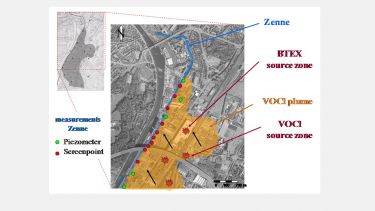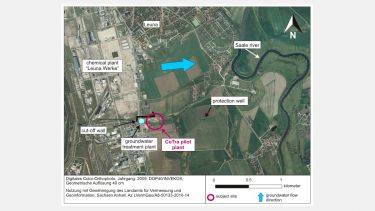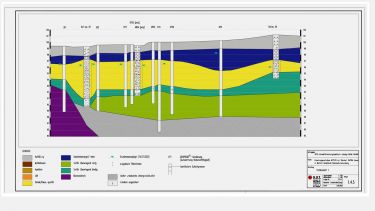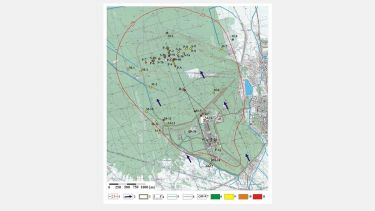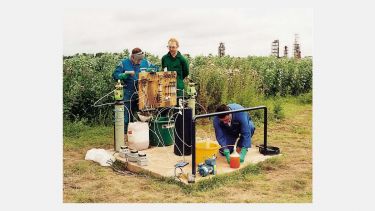Field sites
The ADVOCATE Project used a diverse range of field sites that were available across the partnership, to host the projects undertaken by the research fellows.
Each site had an established monitoring infrastructure and history of prior research completed by the project partners, to support the research training undertaken by the Fellows within ADVOCATE.
These sites provided the technical and practical foundation for the training completed by the Fellows within the project by supporting the following activities :
- Hosting fundamental and applied research completed within each Fellowship and across research teams in different work packages
- Access to environmental samples for related laboratory process studies
- Platform for field-scale demonstration of in situ remediation processes, concepts and technologies
- Scientific and technical training of Fellows in environmental sampling and monitoring methods, including the application of innovative measurement and investigation techniques used and developed within the project, through individual projects and the programme of workshops and summer schools provided by the partnership
- Experiential training of Fellows in business, commercial and technical aspects of contaminated site management and remediation, through the programme of secondments and work placements provided within the partnership
See details of each field site below.
- Belgium
-
A chlorinated solvent-contaminated brownfield site with complex source area
This field site was an unconfined alluvial aquifer consisting of Quaternary silty sand and gravel over glauconite sands.
There was extensive groundwater contamination by mono-aromatic and chlorinated aliphatic hydrocarbons in the Quaternary aquifer, which is drained by the River Zenne. The source zone was complex as the area consists of a mix of residential developments and (abandoned) industrial sites, with a history of over 100 years of industrial activity.
Previous studies showed that the plume is strongly heterogeneous, probably due to heterogeneity in aquifer hydraulic conductivity, transport properties and in situ biodegradation capacity. The importance of chlorinated solvent attenuation by the River Zenne sediment had also been demonstrated.
The groundwater monitoring infrastructure at the site comprises a network of 38 installations, which include single-screen wells and piezometers that chracterise the plume chemistry, contaminant distribution and in situ biodegradation processes for the chlorinated solvents. Remediation strategies included pump-and-treat for the groundwater plume, and soil excavation and multiphase extraction at contaminant hot spots.
- Germany
-
Petroleum hydrocarbon and MTBE refining plant on shallow alluvial aquifer
This field site is an unconfined alluvial aquifer consisting of coarse sands and gravels and other Quaternary glacial deposits interbedded with Tertiary sediments, over sandstone bedrock.
The groundwater flow regime was complicated by the heterogeneous sedimentary architecture, industrial infrastructure and influenced by the surface morphology. The aquifer was contaminated with ammonium, MTBE, BTEX and other aromatic hydrocarbons derived from petroleum refining over many decades.
The site is classified as a contaminated "megasite", based on the large scale and complexity of soil and groundwater pollution. Remediation infrastructure includes a cut-off wall to contain plume migration, supported by a pump and treat system with water-stripping. Previous research has focused on the potential for natural attenuation and demonstration of in situ remediation technologies for MTBE.
Activities included the development and pilot-scale evaluation of low-intensity biological and sorption-based remediation technology concepts, such as constructed experimental wetlands. The site was included within a wider programme of remediation technology demonstration for large-scale industrially-contaminated land.
- Poland
-
Chlorinated solvent-contaminated site on shallow alluvial aquifer
This field site was an unconfined alluvial aquifer consisting of interbedded gravels, sands, slits, clays and other Quaternary river deposits, which had been contaminated by chlorinated solvents (PCE and TCE) released from a former metal works and ammunition factory.
Previous research showed that the chlorinated solvents were attenuated by different processes, including biodegradation and sorption, within the heterogeneous aquifer sediments, but the contaminant plume is sustained by a complex source area at the site.
The groundwater monitoring infrastructure at the site included a network of single screen monitoring wells and piezometers, which provided high-resolution monitoring of the plume chemistry, contaminant distribution and in situ biodegradation processes for the chlorinated solvents.
The site was being evaluated for the installation of an in situ permeable reactive barrier to support the remediation plan.
- Switzerland
-
Lowland river catchment site influenced by nutrient dynamics and organic-micropollutants
This field site was a partly restored river in an alpine rural setting on arable farmland in a lowland catchment. It was situated on a shallow unconfined/confined sand and gravel aquifer which overlies limestone-sandstone bedrock.
Previous research showed that there was high spatial and temporal variability in flow velocity and direction though the riverbed and across the groundwater-surface water interface, linked mainly to large fluctuations in the river stage. However, in general, the river water inflitrates into the aquifer.
The monitoring infrastructure at the site included a network of 50 piezometers arranged in transects, many fitted with dataloggers, which allowed simultaneous sampling of water chemistry and hydraulic head across the groundwater-surface water interface. This was supported by observation towers and monitoring stations for meteorological, ecological and soil measurements.
The piezometer network provided high spatial and temporal resolution monitoring of solute distributions, fluxes, in situ biodegradation processes, hydraulic properties and transport pathways through the riverbed for nutrients and organic micropollutants.
The site was a research facility for studies of pollutant natural attenuation at the groundwater-surface water interface and pollutant fate and transport by river bank inflitration.
- United Kingdom
-
Phenol-contaminated site on sandstone aquifera
This field site was located on an unconfined sandstone aquifer, which had been contaminated by phenolic compounds (phenol, cresols and xylenols) from a former tar-acid distillation plant.
Previous research showed that the phenolic compounds were biodegraded in the aquifer under a range of redox conditions (from aerobic respiration to methanogenic fermentation) and that biodegradation processes were strongly influenced by the contaminant matrix.
The groundwater monitoring infrastructure at the site included a network of single screen monitoring wells and multilevel samplers (MLS). The MLS had sampling points at intervals of 0.25-1m, which provided high-resolution monitoring of the plume chemistry, contaminant distribution and in situ biodegradation processes, including detailed analysis of the bioreactive plume fringe at the interface between the background groundwater and plume.
A pump and treatment system was in operation at the site, as part of the plume management strategy.

ADVOCATE Project
ADVOCATE developed innovative in situ remediation concepts for the sustainable management of contaminated land and groundwater.

